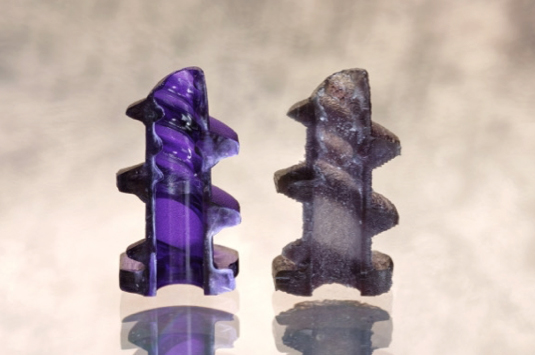Experimenting with Micromolding and 3-D Printing

The advantages of 3-D printing as a model and prototype-making process have excited the overall product development community. This is because of quick lead times and new design freedoms that offer flexibilities not found in previous tooling-based prototyping and modeling technologies. In fact, for some very low-quantity applications, such as personalized medical implants, 3-D printing has reportedly been used as a limited-run production technology. Therefore, it is natural that the successes experienced by those using the method in the “Macro-world” would inspire similar experimentation in the “Micro-world”, too.
Identifying the Problem: Choosing Processes
3-D printing is 100% process, meaning the process converts engineering data directly into three-dimensional products, using a projectile printing technology like ink jet printing (the technology used in document printers). No form tool is used to create the shape of the finished part, so all locational and tolerance-based requirements are dependent on the accuracy and repeatability of the process delivering the projectiles to the correct locations. This is a tall order in the macro-world, but it is a tremendous challenge in the micro-world, as the photos show in Figures 1a and 1b .
Micromolding, on the other hand, is a combination of several processes (injection molding plus tooling plus material science, etc.).
Engineering Dilemma
So the dilemma for most development engineers is in determining whether the short delivery time and low sample cost of a 3-D printed part outweigh the disadvantages of potential loss of critical micro-feature definition, reduced material choices, and possibly the loss of the ability to functionally test.
To clarify the dilemma in terms of the loss of feature definition, a quick visual comparison of the two parts shown in Figures 1a and 1b illustrates the problem. A considerable difference exists between the clarity of the features created using 3-D printing and micromolding. In this case, the 3-D printed parts were formed using a high-precision printer operating at only a 16 µm thick deposition layer and 25 µm off-set. The expectation was that this new process would provide very close parity with the micromolded features.
The Solution: Critical and Functional for Testing vs. Desirable and Needed Only for Constructing a Model
The answer to whether 3-D printing will be sufficient or whether a part must be hard-tooled in micromolding might become clear once the need for micro-sized features is determined. Are they desirable, or are they critical to function? The same is true for the number of parts required: Is the need limited to a handful of parts, or will thousands of pieces be needed? The suitability of materials is also crucial, especially if dynamic, dielectric, biocompatibility, or rate of absorption testing are required.
Benefits Summary
Fine, micro-sized features on miniature plastic parts can be produced in abundance using micromolding. The method is consistent, reliable, and cost effective for production applications due to mass production and high volume capability.
3-D Printing of Mold Inserts
As one case example, we investigated whether 3-D printing could be used for printing mold inserts with the fine details required for a customer’s miniature medical part designs. A printer attempted to 3-D print the inserts with two types of materials to achieve the needed detail. Shown on the left is the steel version of the mold insert. In the middle is the first attempt to 3-D print the part. While the second attempt, shown on the right, was a big improvement from the first, the achieved geometry was unfortunately not sharp and crisp enough to allow them to be usable.
Current available technology allows 3-D printing as an option only for limited, simpler geometries. There is technology for achieving micro detail, however. This technology shows that ultra-precise 3-D printing can be done on a micro scale, so our expectation is it will eventually grow to a larger platform to allow us to use the technology for our mold inserts. As it stands now, there is a gap between tiny, fine-detail 3-D printing and larger, without-fine-detail 3-D printing. This gap is already starting to close, giving us hope that the technology will be expanded to a more useful size in the near future. Technology for printing is now here, and the challenge is to feed it to something useful so that prototyping can be done with this machine. The idea is to scale up the technology and add more options for materials to be useful for prototyping, making it more useful to the world—specifically the medical device world.